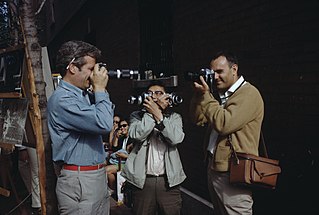
Photography is the art, application, and practice of creating images by recording light, either electronically by means of an image sensor, or chemically by means of a light-sensitive material such as photographic film. It is employed in many fields of science, manufacturing, and business, as well as its more direct uses for art, film and video production, recreational purposes, hobby, and mass communication.

Ansel Easton Adams was an American landscape photographer and environmentalist known for his black-and-white images of the American West. He helped found Group f/64, an association of photographers advocating "pure" photography which favored sharp focus and the use of the full tonal range of a photograph. He and Fred Archer developed a system of image-making called the Zone System, a method of achieving a desired final print through a technical understanding of how the tonal range of an image is the result of choices made in exposure, negative development, and printing.

Photojournalism is journalism that uses images to tell a news story. It usually only refers to still images, but can also refer to video used in broadcast journalism. Photojournalism is distinguished from other close branches of photography by having a rigid ethical framework which demands an honest and impartial approach that tells a story in strictly journalistic terms. Photojournalists contribute to the news media, and help communities connect with one other. They must be well-informed and knowledgeable, and are able to deliver news in a creative manner that is both informative and entertaining.

Mathew B. Brady was an American photographer. Known as one of the earliest and most famous photographers in American history, he is best known for his scenes of the Civil War. He studied under inventor Samuel Morse, who pioneered the daguerreotype technique in America. Brady opened his own studio in New York City in 1844, and went on to photograph U.S. presidents John Quincy Adams, Abraham Lincoln, Millard Fillmore and Martin Van Buren, among other public figures.

Sally Mann HonFRPS is an American photographer known for making large format black and white photographs of people and places in her immediate surroundings: her children, husband, and rural landscapes, as well as self-portraits.

The American Civil War was the most widely covered conflict of the 19th century. The images would provide posterity with a comprehensive visual record of the war and its leading figures, and make a powerful impression on the populace. Something not generally known by the public is the fact that roughly 70% of the war's documentary photography was captured by the twin lenses of a stereo camera. The American Civil War was the first war in history whose intimate reality would be brought home to the public, not only in newspaper depictions, album cards and cartes-de-visite, but in a popular new 3D format called a "stereograph," "stereocard" or "stereoview." Millions of these cards were produced and purchased by a public eager to experience the nature of warfare in a whole new way.

Asahel Curtis (1874–1941) was a photographer based in the Pacific Northwest region of the United States. His career included documentation of the Klondike Gold Rush period in Seattle, natural landscapes in the Northwest, and infrastructure projects in Seattle.

Frances Benjamin Johnston was an American photographer and photojournalist whose career lasted for almost half a century. She is most known for her portraits, images of southern architecture, and various photographic series featuring African Americans and Native Americans at the turn of the twentieth century.

A Colonial Revival garden is a garden design intended to evoke the garden design typical of the Colonial period of the United States. The Colonial Revival garden is typified by simple rectilinear beds, straight pathways through the garden, and perennial plants from the fruit, ornamental flower, and vegetable groups. The garden is usually enclosed, often by low walls, fences, or hedges. The Colonial Revival gardening movement was an important development in the gardening movement in the United States.

Flowerdew Hundred Plantation dates to 1618/19 with the patent by Sir George Yeardley, the Governor and Captain General of Virginia, of 1,000 acres (400 ha) on the south side of the James River. Yeardley probably named the plantation after his wife's wealthy father, Anthony Flowerdew, just as he named another plantation "Stanley Hundred" after his wife's wealthy mother, Martha Stanley. A "hundred" was historically a division of a shire or county. With a population of about 30, the plantation was economically successful with thousands of pounds of tobacco produced along with corn, fish and livestock. Sir George paid 120 pounds to build the first windmill in British America.

Nude photography is the creation of any photograph which contains an image of a nude or semi-nude person, or an image suggestive of nudity. Nude photography is undertaken for a variety of purposes, including educational uses, commercial applications and artistic creations.

Vivian Dorothy Maier was an American street photographer whose work was discovered and recognized after her death. She took more than 150,000 photographs during her lifetime, primarily of the people and architecture of Chicago, New York City, and Los Angeles, although she also traveled and photographed around the world.
Robert Clayton Lautman was an American architectural photographer.

Fine art nude photography is a genre of fine-art photography which depicts the nude human body with an emphasis on form, composition, emotional content, and other aesthetic qualities. The nude has been a prominent subject of photography since its invention, and played an important role in establishing photography as a fine art medium. The distinction between fine art photography and other subgenres is not absolute, but there are certain defining characteristics.

The Old-Growth Forest Network is an American 501(c)(3) non-profit organization whose mission is to protect old-growth forests from logging by identifying them throughout the United States.
Rob Amberg is a North Carolina photographer, folklorist, and chronicler of a small Madison County mountain community, Revere, North Carolina, which he depicted in his long-term photo project Sodom Laurel Album. Amberg anticipated the completion of highway I-26 from Charleston, South Carolina, to the Tennessee Tri-Cities area and, starting in 1994, began photographing, interviewing, and collecting objects to document the cutting of a nine-mile stretch of I-26 through some of North Carolina's most spectacular vistas and some of the world's oldest mountains—a project which contributed to the publication of his book The New Road. His documentary photography is archived in a collection at Duke University Library.
Barbara Bosworth is an American artist, educator, and photographer. She works primarily with a large-format, 8x10 view camera and focuses on the relationship between humans and nature. Bosworth's works have been included in magazines, journals, books and permanent collections, and shown in solo exhibits nationally and internationally. In 1985, she won a Guggenheim fellowship for her photographic work.
On August 12, 2017, DeAndre Harris, a Black man, was assaulted by six White men in an attack in a parking garage next to the police headquarters during the Unite the Right rally in Charlottesville, Virginia, United States. Images and video of the assault captured by photojournalist Zach Roberts went viral and became a symbol of the enmity underlying the protest.

Ryan Kelly is an American photojournalist. He won the Pulitzer Prize for his work on the 2017 Unite the Right Rally in Charlottesville, Virginia, for a photograph showing a man running over protestors.

Joan Maloof is an American environmental activist and author. She founded the Old-Growth Forest Network in 2012.
















